|
Sample Return Capsule
(SRC)
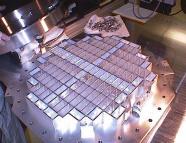 |
|
Aerogel Collector
|
|
The Sample Return Capsule is a compact system,consisting
primarily of a sample canister with an aeroshield/basecover,
plus navigation recovery aids, an event sequencer
and a small parachute system.
The sample canister is designed to hold and protect
the dust particles collected during the Stardust
flight - the most important goal of the mission
being to bring these back safely. On its base,
an aeroshield serves as a cover. In flight this
opens like a clamshell, allowing the aerogel dust
collector grid to encounter dust.
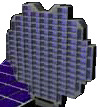 The
SRC stores the samples of cometary and interstellar
dust securely in the sample canister, by folding
it inside and tightly closing. Just prior to Earth
encounter, the SRC is released, once the spacecraft
sets up the proper flight trajectory and entry
angle, and imparts a stabilizing spin to the Capsule.
The spin adds to the SRC stability in flight. The
SRC stores the samples of cometary and interstellar
dust securely in the sample canister, by folding
it inside and tightly closing. Just prior to Earth
encounter, the SRC is released, once the spacecraft
sets up the proper flight trajectory and entry
angle, and imparts a stabilizing spin to the Capsule.
The spin adds to the SRC stability in flight.
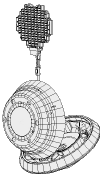 Upon
entering the Earth's atmosphere the capsule passively
stabilizes as a result of its center of gravity,
spin rate and aerodynamic shape. After entry the
SRC will continue to free-fall until approximately
2 miles (3 km) above the ground, at which point
the parachute deployment sequence will initiate.
The planned landing site is the Utah Test and
Training Range (UTTR). Upon
entering the Earth's atmosphere the capsule passively
stabilizes as a result of its center of gravity,
spin rate and aerodynamic shape. After entry the
SRC will continue to free-fall until approximately
2 miles (3 km) above the ground, at which point
the parachute deployment sequence will initiate.
The planned landing site is the Utah Test and
Training Range (UTTR).
The reentry landing accuracy has been analyzed
and it is believed to be possible to achieve a
landing footprint of 84 km by 30 km - well within
the Range area. To slow the capsule, a reinforced
ring-slot descent chute will be deployed with
the aid of a pilot chute. The descending capsule
will have a UHF beacon and the parachute will
be tracked by ground radar, so it is expected
to be easy to locate.
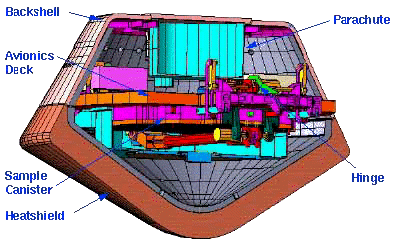 Following
touchdown, the SRC will be recovered by helicopter
or ground vehicles and transported to a staging
area at UTTR for retrieval of the sample canister.
The canister will then be transported to the planetary
materials curatorial facility at Johnson Space
Center for examination. Following
touchdown, the SRC will be recovered by helicopter
or ground vehicles and transported to a staging
area at UTTR for retrieval of the sample canister.
The canister will then be transported to the planetary
materials curatorial facility at Johnson Space
Center for examination.
Collector Grid
Collection of cometary particle samples is accomplished
by simply exposing blocks of aerogel to the material
it encounters during spaceflight.
The dust collector media consists of blocks of
1 and 3 cm thick underdense, microporous silica
aerogel mounted in modular aluminum cells. This
is similar to what was used for previous exposures
during Shuttle and MIR experiments. For the Stardust
mission, cells in a grid holding aerogel are mounted
on a two-sided, tennis racket-shaped array that
will deploy from the Sample Return Capsule (SRC).
After exposure, the array will fold compactly
for stowage inside the sample Earth return capsule
for the trip back to Earth.
One side of the aerogel will be used to collect
samples during the comet encounter and the reverse
side - sometimes called the "B-side"
- will be used for interstellar collection. The
useful collecting areas are identical, with 1000
cm2 for interstellar dust grains and 1000 cm2
for cometary dust. These collectors are totally
inert and only need to be exposed and then stowed
after they are used.
Earth Return Sequence
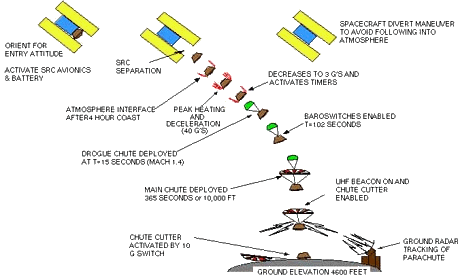
The Sample Return Capsule will perform a direct
entry at Earth. After entry the SRC will continue
to free-fall until approximately 3 km, at which
point the parachute deployment sequence will initiate.
The planned landing site is the Utah Test and
Training Range (UTTR).
The reentry to landing accuracy has been analyzed
and found to be sufficient to achieve a landing
footprint of 84 km by 30 km. - well within the
Utah Test and Training Range. A reinforced ring-slot
descent chute will be deployed with the aid of
a pilot chute. The descending capsule will have
a UHF beacon and the parachute will be tracked
by ground radar.
Following touchdown, the SRC will be recovered
by helicopter or ground vehicles and transported
to a staging area at UTTR for retrieval of the
sample canister. The canister will then be transported
to the planetary materials curatorial facility
at Johnson Space Center.
| Last updated
November 26, 2003 |
|
